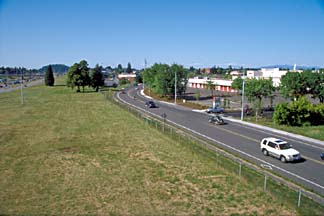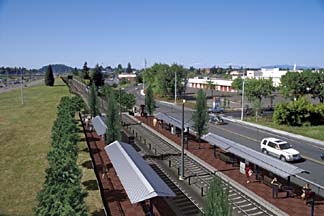 |
||||||||
| FEATURE ARTICLES | Memo Calendar | Memo Pad | Business Memo's | Loaves & Fishes | Letters | Home | ||
Local, regional issues revolve around a Gateway to Clackamas Town Center Line city officials endorse
LEE PERLMAN
THE MID-COUNTY MEMO
The city of Portland, Metro and Tri-Met have begun planning for Phase One of the South Transportation Corridor. As far as East Portland is concerned, that is a new MAX light rail line that would go from downtown, through Gateway, then proceed south along the I-205 right of way 6.7 miles to Clackamas Town Center, at a cost of $349 million.
 |
| Existing roadway adjacent to I-205 at Main Street and 96 Avenue. |
 |
| Simulation of I-205 light rail station at Main Street and 96 Avenue serving the Gateway community – Mall 205 and Adventist Hospital. |
Planning has barely begun, but already Gateway and Hazelwood residents have an issue. Plans so far call for a station at Southeast Main Street. This, Hazelwood Neighbor-hood Association president Arlene Kimura says, might serve Adventist Medical Center, but would bypass Mall 205 and the heart of Gateway. Hazelwood feels a station at Southeast Washington Street would make more sense.
Planner Dave Unsworth of Metro says that a Washington station would have to be placed in a location that would be hazardous for pedestrians to get to. Tri-Met planner Phil Sellinger says that since there already is a MAX station in Gateway, a Main station would provide service to a broader area. He also says Tri-Met has heard public support for the plan in some community meetings, including one Opportunity Gateway Program Advisory Committee (PAC) meeting. Dick Cooley, PAC chair, says the group never discussed the matter in detail.
The larger picture
There are regional issues swirling around the route. Community activists in southeast Portland and Milwaukie were given credit by many for reviving the effort to extend light rail south to Clackamas County after political leaders had abandoned the idea. Several of them were visibly miffed that planners had decided to proceed first with an I-205 route.
Commissioner Jim Francesconi said I-205 was given preference because it was cheaper, required little new property acquisition, the potential ridership based on projected development is “surprisingly high, higher than the inner southeast,” and it represented a chance to provide infrastructure improvements to Gateway. “We need to make an investment in East Portland, and we need federal funds to do it,” he said.
Several Lents residents and community leaders raised concerns about the plan, based on the feared impact of the project on the surrounding neighborhood and past experience with city projects such as I-205. The neighborhood association and urban renewal advisory committee both voted “non-support” for the proposal.
Francesconi seemed annoyed by the remarks. “Those who benefit need to participate,” he said. “I’m hearing negative things from Lents and Gateway, when they’re getting things the inner southeast should die for.” He added, however, that the city “can’t repeat the experience of Interstate.”
The North Interstate light rail project created a new urban renewal district to fund the project. Surrounding communities added extensive wish lists of their own for the funds. However, for a variety of reasons, for the next few years at least there will be little funding for anything except the MAX line.
Cooley, who made a brief statement at the hearing, later told the PAC, “I said that we love it, but we don’t want to pay for it.” Mayor Vera Katz, who pushed forward the Interstate district, acknowledged the point. “The use of urban renewal funds was a tool we used when we had no alternatives,” she said. “For the future this is a regional system, and it shouldn’t be (financed) all on the backs of the people in the alignment.”
In fact, funding for the project has yet to be determined, let alone secured. Several speakers noted that since the defeat of a levy to finance a line from Vancouver to Clackamas Town Center, the city has twice put together funding packages that avoided a public vote. Planners hope to get federal funding for 60 percent of the cost. The planning and public involvement process will pick up again in late summer.
MEMO Advertising | MEMO Archives | MEMO Web Neighbors | MEMO Staff | Home